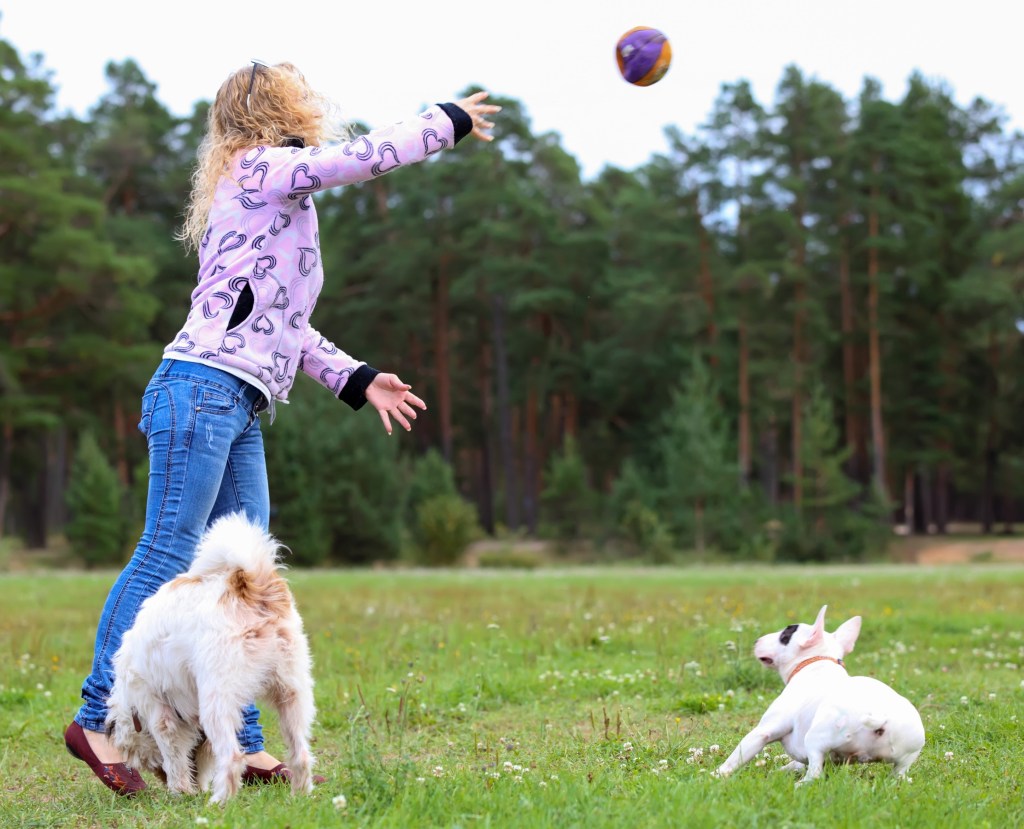The Joy of a Well-Thrown Ball
It is summertime and pool season is in full swing at our house. This means daily swimming and retrieving for our dogs. They love nothing better than an afternoon at the pool with friends and lots (and lots) of toy-throwing into the water. (Our dogs seem to view human friends who come to the pool as bodies with throwing arms attached).
Ball-Throwing Competency
We have noticed over the years that visitors vary considerably in their, should we say, “ball-throwing talents”. Some nail it every single time, with the ball landing in the middle of the pool, well positioned for the perfect leap, swim and grab. Others, well…..not so much. We have one male friend who is lucky if the toy even makes it into the pool, and another who pretty consistently launches balls that land completely outside of the pool area fence.
So, do dogs notice the range of ball-throwing skills among their human pals? Do they know, for instance, that Sally consistently throws the perfect pool toy, while Peter is more apt to send anything he touches straight up into the air? Will they gravitate to those who consistently show the best ball-throwing talent?
(Do they tend to avoid Sarah?)
Competency Assessment in Dogs – A Cognitive Skill
Canine cognition studies have demonstrated that dogs are capable of understanding and reacting to a wide range of human social cues, emotions, and even intentions. One particular form of social cognition is having the ability to assess the competency of another individual and to then change one’s behavior accordingly. Competency assessment, especially when conducted in third person (i.e. watching a person interact with someone else), is generally considered by social scientists to be a relatively complex cognitive skill.
A recently published paper examined this form of cognition in dogs. The researchers asked: “Are dogs able to assess the competency of a person by simply observing the person (for example, throw a ball), and then predict his or her “ball-throwing talent” for future interactions?“
The Study
Dogs who enjoy a good ball toss game were invited to participate. Twenty-two adult dogs were subsequently recruited and each dog was tested individually.
Observation Phase: In the observation phase, the dog was held in a spot that was equidistant from two experimenters who stood about 30 feet apart and were either throwing or kicking a ball between them. By design, one of the experimenters was highly skilled (competent) and propelled the ball accurately to the other person. Conversely, the second person was not skilled (incompetent condition) and could only propel the ball about 3 feet towards his/her partner. The dog observed four total throw or kicks in each observation period.
Test Phase: Following completion of the observation phase, the dog was released and allowed to interact with each experimenter in the two types of activity – throwing or kicking the ball. The experimenter played with the dog by fake throwing or fake kicking the ball. The dog was free to run as far as he/she liked in anticipation of the experimenter’s toss or kick.
Data Collected: The distance that the dog ran in (in anticipation) was measured in all four conditions (competent/incompetent person and throw/kick activity).
Results
Well, the dogs had some opinions.
After having had the opportunity to observe both a competent and an incompetent ball launcher, on average the dogs ran significantly farther when playing with the competent experimenter compared with when they were playing with the incompetent experimenter. This difference was larger when the ball was thrown than when it was kicked, but was consistent for each condition. Moreover, competency in each action was not consistent within the experimenter and the dogs were capable of reacting to these inconsistencies. In other words, a competent thrower might be an incompetent kicker and vice-versa. The dogs demonstrated an ability to keep these actions separate and to remember that a given individual was good at one of the activities, but not the other, and to alter his or her running distance accordingly. WOW.
It appears that my dogs are judging our ball-throwing skills whilst at the pool……
Take Away for Dog Folks
First, I need to clear up the elephant in the room.
If you are a regular reader of The Science Dog, you know that I strongly eschew any form of training or play that causes frustration in our dogs, or that may negatively impact their trust in us. I have written about using the “fake throw” as a type of teasing (and why we of course should not do it).
So, in truth, the use of fake throws in this study made me a bit uneasy. I disliked the image of dogs being deceived, especially after being required to sit quietly and watch two people play ball together. However, this discomfort is mitigated by knowing that the throws comprised only a handful of interactions, were in a novel setting, and occurred with unfamiliar people (the experimenters). Although it was not addressed in the paper, it is my hope that following the experiment, each dog was given the opportunity to actually chase and retrieve the ball and to enjoy interacting with the experimenters (regardless of how great a ball thrower or kicker they may have been).
It is important to emphasize that the dogs in this study not only showed an ability to assess two types of action-specific competencies in humans; they achieved this via a third-person paradigm. In other words, the dogs were not assessing an individual’s person’s ball-launching skill as they played with that person. Nope – they did something that is much more complex. They assessed competency by watching two people toss or kick a ball back and forth to each other – and for just a handful of repetitions, at that. The dogs then took that information and used it to alter their own behavior when they anticipated how far one of those individuals would be able to launch a ball for the dog’s retrieval.
In all honesty, I am not sure how efficiently I could even do this. I am astounded and amazed, once again, by our wonderful, oh-so-smart, and play-loving dogs.
Cited Study: Hassall RS, Neilands P, Pinkusfeld Am Bastos M, Taylor AH. Dogs assess human competence from observation alone and use it to predict future behaviour. Learning and Motivation 2023; 83:101911. doi.org/10.1016/j.lmot.2023.101911






